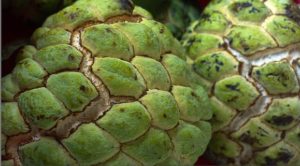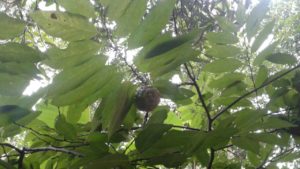As a child, I was very particular about the choice of fruits – especially their geometry. It had to have proper edges and cut with a sharp knife. So anything squishy or a little too ripe – I would avoid. That is why I befriended the best fruits like mango, jack fruit and custard apple only much later in life.
I was introduced to Sitaphal, by my Ammamma. I was reluctant to eat it because I’d spotted tiny white cocoon like formation in the crevices of the fruit. But fascination overrode reluctance. The segmented green cover with shades of black here and there and the cottony, white pulp inside with black seeds seemed to satisfy my geometric demands.
Unlike the other fruits, Ammamma would split it open in justifiably equal portions, depending on the number of takers. Ammamma lured me, scooped the sitaphal with a spoon to convince me that it is similar in texture to ice cream. I put a spoonful in my mouth and there was an explosion of sugary delight. It was sweet. Not the pinkish kind but say Vanilla is grass, and you uproot it from its soil – that is the taste of Sitaphal.

Image Credits – Gunjan Karun via Flickr
She then let go of the eating-with-spoon formality. The desi and tasty way to relish this fruit is to take an entire half in the hollow of the palm, positioning it to the edge of the fingers and scraping it on the lower set of teeth.
Eating it is a treat to the taste buds, and an exercise at the same time. The texture changes from pulpy to creamy and grainy while reaching the base of the skin. The struggle to separate the pulp from the seed with the tongue is the real fun part of it; the challenge is to not choke on the seeds.
And then there is the shooting game- who can shoot out the seed farthest, plus the added fun of irritating chechi by the clicking noise of seeds falling on the steel plate.

There is a slender Sitaphal tree growing in the backyard at home. Ammamma gives it special nourishment – she speaks to it and scolds it, but it never gives her anything in return except stunted tiny fruits. And then came a day when Ramphal made an entry into Ammamma’s life. Ammamma’s eating process is only complete when she plants a seed to ensure constant supply in the future. And so she did it. It grew to become a sturdy tree, yielding plenty of fruits.
Sitaphal and Ramphal are from the same family. Let’s just say they are cousins who could marry each other. All my life, I have called sitaphal custard apple, only to be corrected by Google unkal recently that it is Sugar apple. True to its name — it’s a sugar load and the pulp will araam se slide off the seed at the slightest pressure by the tongue. Ramphal has lesser seeds, however, the pulp attached to the seed will just not come off, the tongue gets exhausted after the long battle. It has a creamier pulp and therefore named custard apple.
I hated the fruit for two reasons. One- it was a rather sour and fermented version of Sitaphal. And two – the smell of the fruit invited unwanted attention – BATS. But being constantly pestered by her to eat it, I started liking the taste.
Plucking it from the tree is like playing Tug of War. The stalk is thick like wood while the fruit is extremely soft and delicate. More than once, the fruit has ripped apart and fallen with a plop sound, making a white pâté-like mess all over the soil. After being scowled at by Ammamma, and constant practice, I have learnt the art of fruit plucking.
Ammamma hides all the axes at home when her son and sons-in-law come during the summer holidays. They say that the tree is growing beyond its limits (the compound wall), and want to chop a few branches during each visit. “We should not create nuisance to the neighbours Amme!”, they say. But Ammamma is a politician. When they leave, she packs tons of fruits for them and so they leave her alone with the tree.

Ammamma
Latest posts by Anisha Ajith (see all)
- Women, playing it Wright - 23rd September 2018
- A Phal Tale - 8th August 2017





